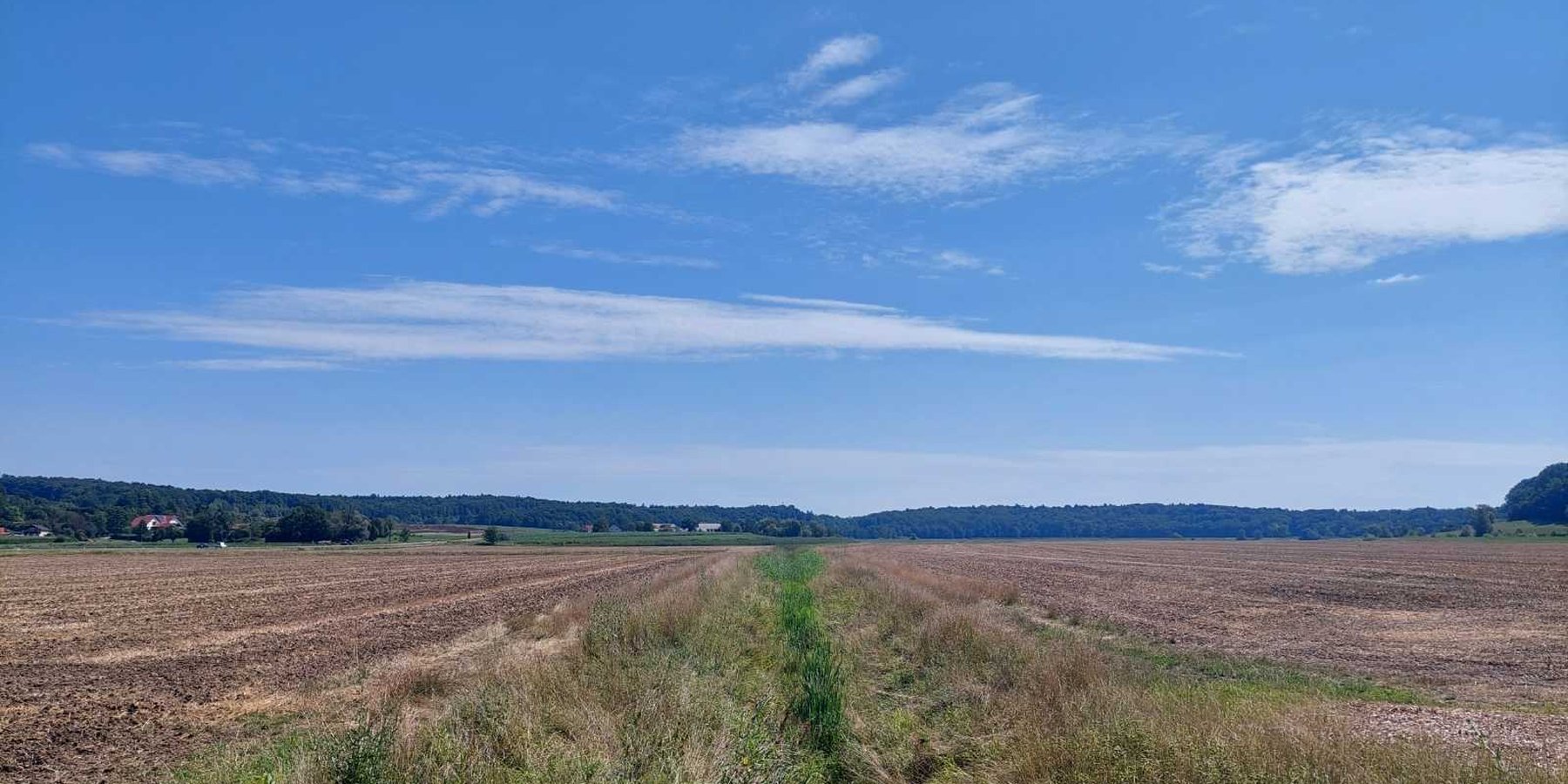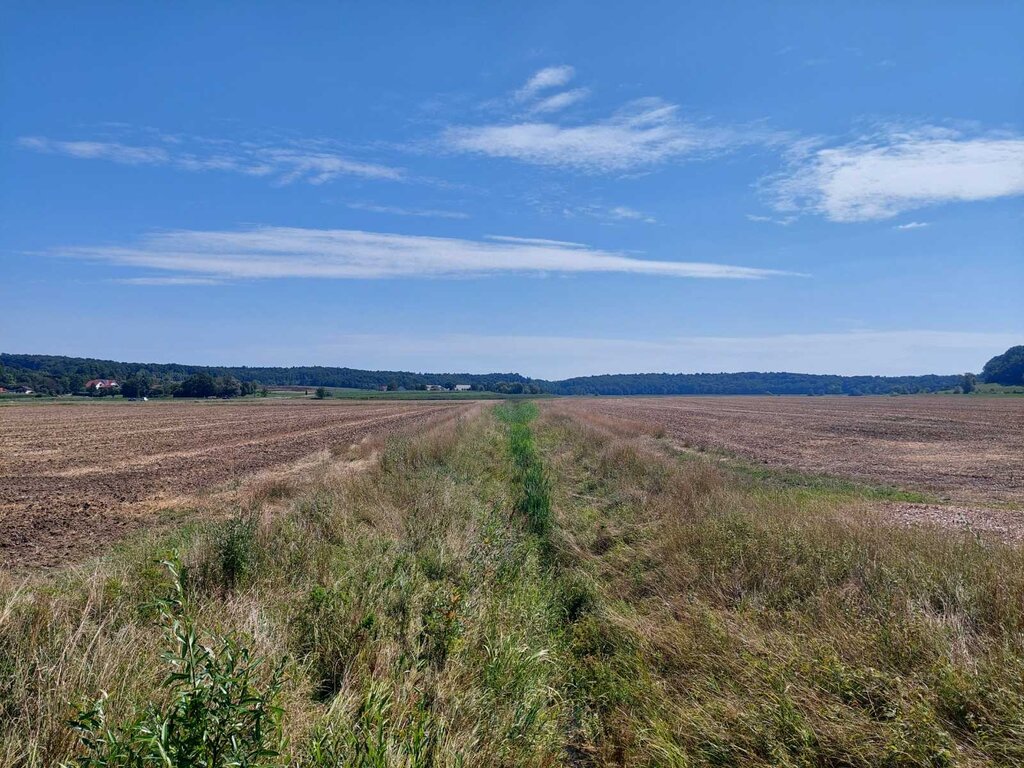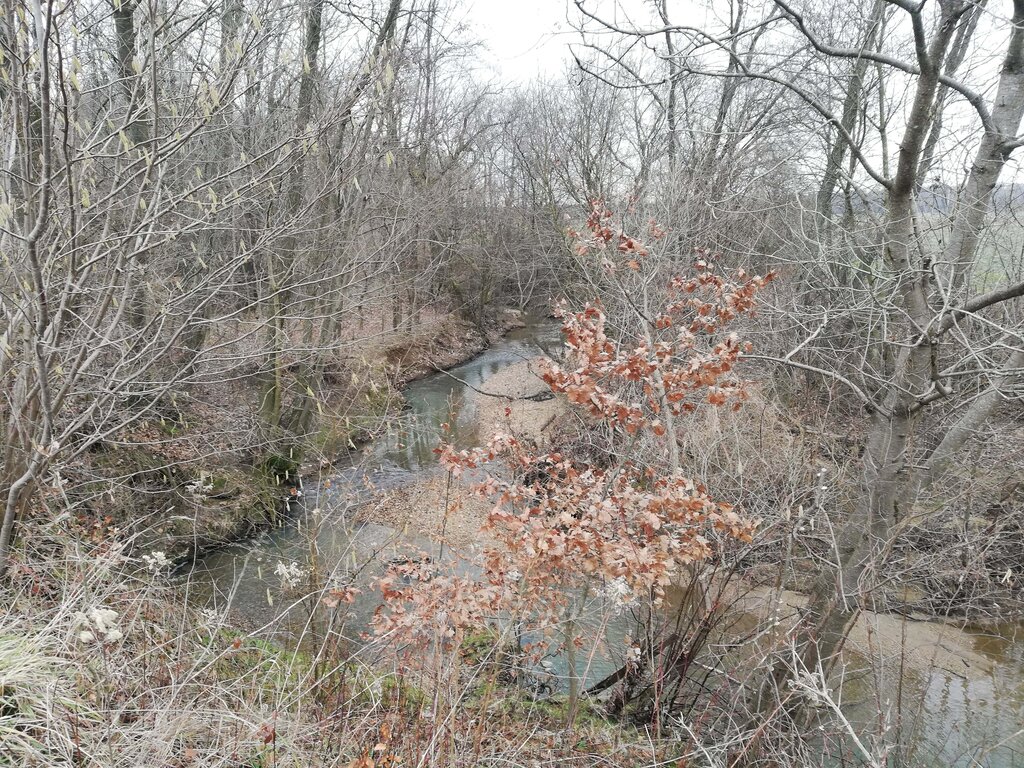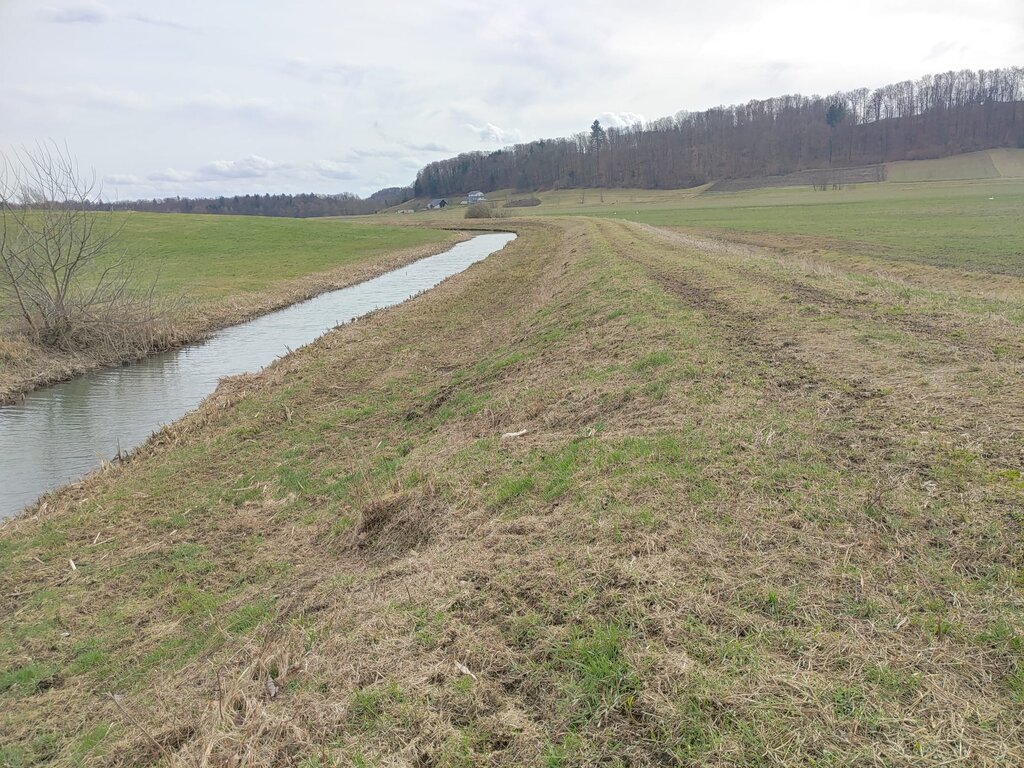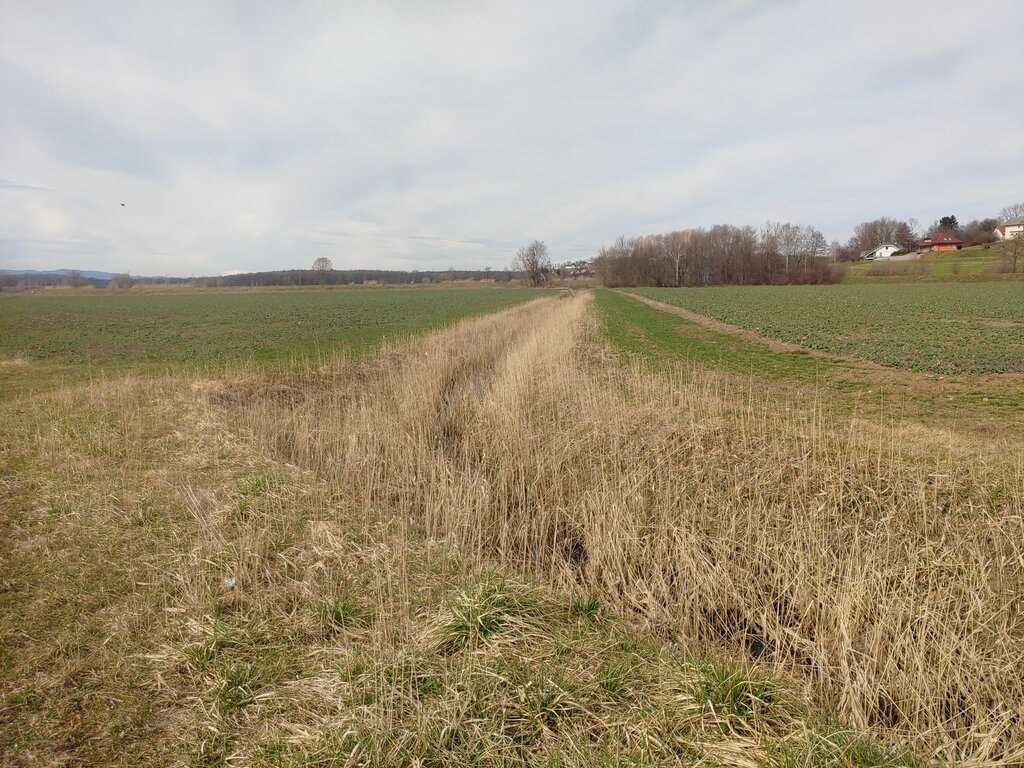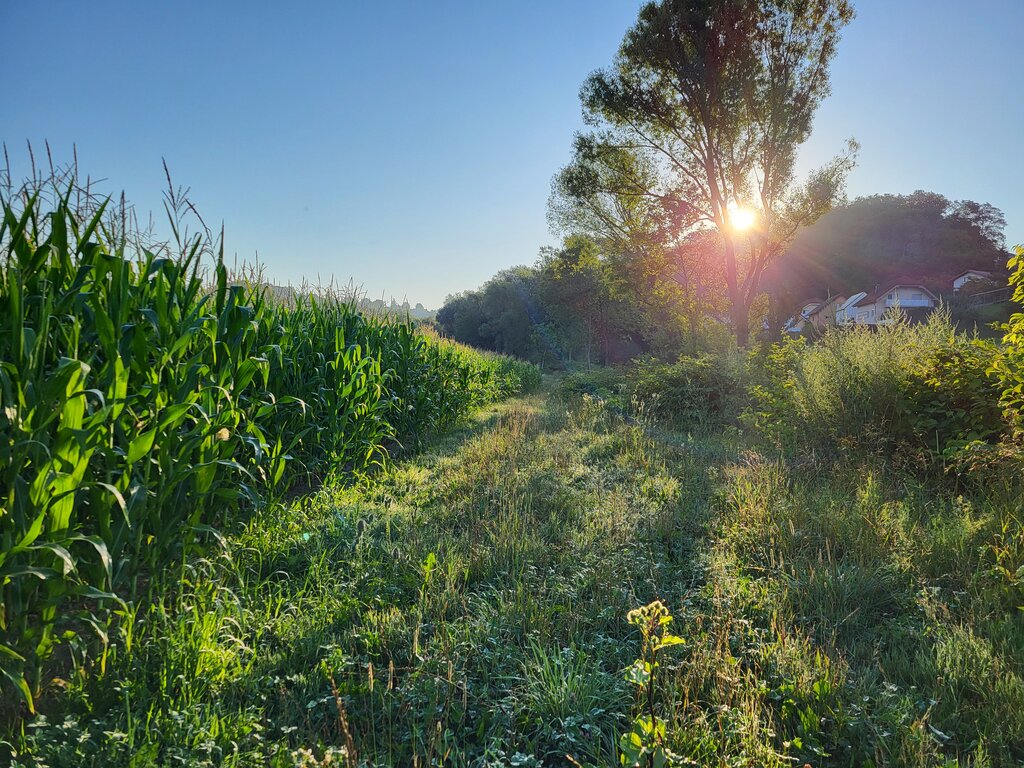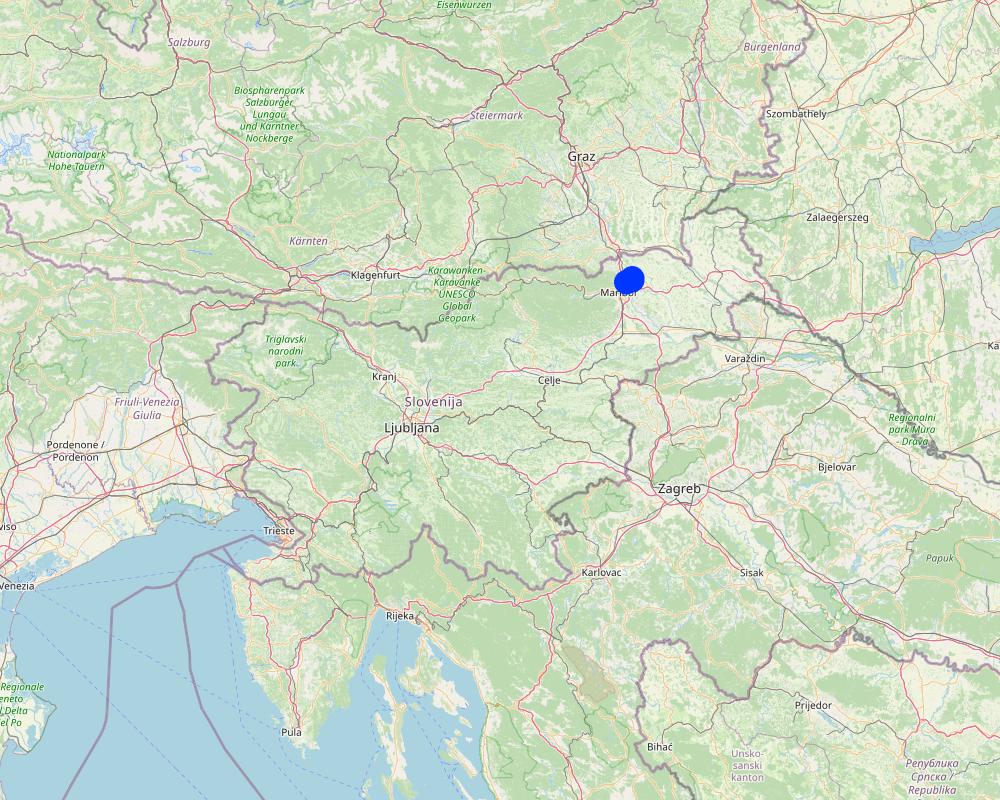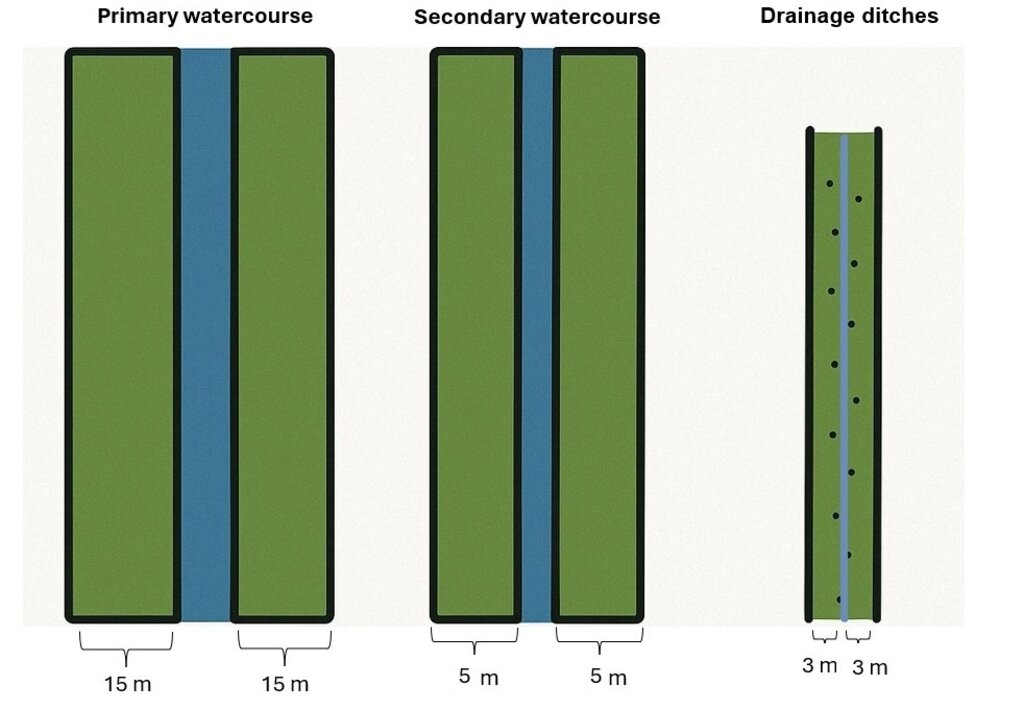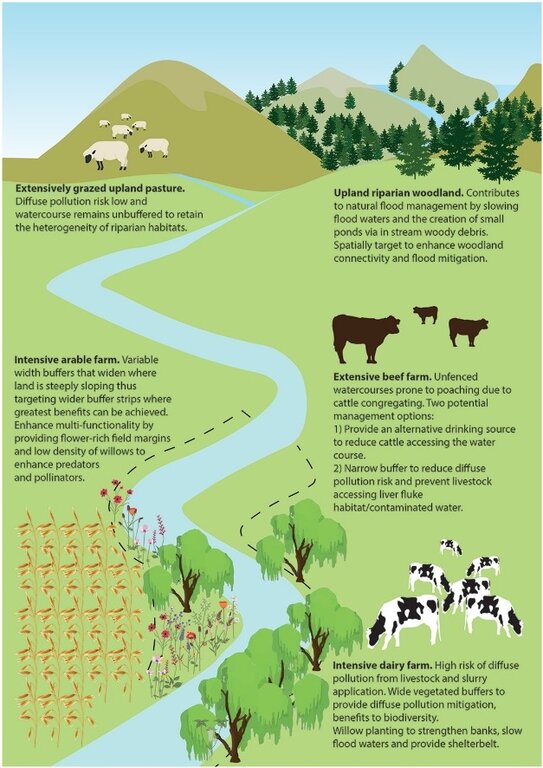Riparian buffer strips [Slovenia]
- Creation:
- Update:
- Compiler: Gregor Kramberger
- Editor: Tamara Korošec
- Reviewers: William Critchley, Rima Mekdaschi Studer
Varovalni pasovi ob vodotokih
technologies_6246 - Slovenia
View sections
Expand all Collapse all1. General information
1.2 Contact details of resource persons and institutions involved in the assessment and documentation of the Technology
SLM specialist:
SLM specialist:
Horvat Timotej
Chamber of Agriculture and Forestry of Slovenia (KGZS) – Institute of Agriculture and Forestry Maribor Slovenia
Slovenia
co-compiler:
Ropič Andrej
Farmer
Slovenia
SLM specialist:
Kep Tina
Chamber of Agriculture and Forestry of Slovenia (KGZS) – Institute of Agriculture and Forestry Maribor Slovenia
Slovenia
Name of project which facilitated the documentation/ evaluation of the Technology (if relevant)
OPtimal strategies to retAIN and re-use water and nutrients in small agricultural catchments across different soil-climatic regions in Europe (OPTAIN)Name of the institution(s) which facilitated the documentation/ evaluation of the Technology (if relevant)
Chamber of Agriculture and Forestry of Slovenia – Institute of Agriculture and Forestry Maribor (KGZS) - Slovenia1.3 Conditions regarding the use of data documented through WOCAT
The compiler and key resource person(s) accept the conditions regarding the use of data documented through WOCAT:
Ja
1.4 Declaration on sustainability of the described Technology
Is the Technology described here problematic with regard to land degradation, so that it cannot be declared a sustainable land management technology?
Nee
2. Description of the SLM Technology
2.1 Short description of the Technology
Definition of the Technology:
Riparian buffer strips are vegetative zones alongside watercourses. In compliance with EU and Slovenia’s Acts, these protective strips reduce soil erosion, filter pollutants, improve water quality, enhance biodiversity and support climate resilience.
2.2 Detailed description of the Technology
Description:
Riparian buffer strips are applied alongside all watercourses and drainage ditches in Slovenia. These buffer zones are legally mandated under the Water Act and GAEC 4 conditionality standards within the EU CAP 2023-2027 framework. Strips, of 3-15 m wide depending on size of the watercourse, serve as transition zones between cultivated fields and waterways, mitigating the impact of agriculture on aquatic ecosystems and surrounding environments.
Strips must comprise grasses, clover, alfalfa, native shrubs, and/or trees. The use of mineral and organic fertilizers is banned, as are pesticides and herbicides. Deep ploughing is prohibited, but surface tillage is allowed for maintenance and sowing (especially if the buffer strip is classified as agricultural land). Grazing is permitted, but with specific restrictions. If the farmer does not maintain the buffer strip, the area is excluded from the system of agricultural land in use and becomes ineligible for any subsidies.
The main purpose of riparian buffer strips is to protect and improve water quality, prevent soil erosion, and support biodiversity. By intercepting surface runoff, they reduce nitrogen, phosphorus, and pesticide contamination from agricultural land. The dense vegetation stabilizes riverbanks. The strips also enhance habitat connectivity for wildlife, providing nesting sites and food sources. Additionally, they play a role in flood mitigation by reducing the speed of stormwater runoff and thus improving water infiltration and retention.
To establish and maintain riparian buffer strips, an initial assessment of existing vegetation and soil determines whether additional planting is needed. If the area lacks sufficient vegetation, direct seeding with suitable species is carried out. Maintenance usually involves mowing, mulching, and occasional pruning. Pruning refers to the removal of overgrown trees and shrubs along the riverbank to prevent spreading onto agricultural land. This work typically requires tools such as a chainsaw and a tractor with a trailer for removing the cut woody material. Farmers must also comply with monitoring and reporting requirements under CAP regulations.
The benefits of riparian buffer strips are primarily environmental. By filtering pollutants before they enter watercourses, they contribute to cleaner water, reduced eutrophication, and improved aquatic ecosystems. They help maintain land productivity in the long term, reducing the need for costly interventions such as dredging or erosion control measures. The vegetation within the strips absorbs carbon, contributing to climate mitigation efforts. Additionally, by complying with regulations, farmers gain access to CAP subsidies and other environmental incentives, making implementation more financially viable.
Despite these advantages, land users have mixed opinions about such strips. Some farmers appreciate the additional forage production, and others find that the buffer zones serve as useful access paths around their fields, making machinery operation easier. However, many landowners dislike the loss of productive farmland, particularly those near first-order watercourses, where wider buffer strips are required. The loss of cultivated land can result in lower crop yields and income reductions, with farms experiencing up to a 6.2% decrease in arable land and financial losses estimated at 7,448 € per farm annually (Lešnik et al. 2024). Some farmers express concerns about the complexity of legal requirements and the costs associated with compliance and maintenance.
While riparian buffer strips are essential for environmental sustainability, their impact on farm economics must be carefully considered. Future strategies may involve flexible width requirements or integration with agroforestry systems to maximize their benefits while minimizing financial burdens.
2.3 Photos of the Technology
2.5 Country/ region/ locations where the Technology has been applied and which are covered by this assessment
Country:
Slovenia
Region/ State/ Province:
Jareninski dol, Pernica
Further specification of location:
Vosek
Specify the spread of the Technology:
- evenly spread over an area
If the Technology is evenly spread over an area, specify area covered (in km2):
137.0
If precise area is not known, indicate approximate area covered:
- < 0.1 km2 (10 ha)
Is/are the technology site(s) located in a permanently protected area?
Nee
Map
×2.6 Date of implementation
If precise year is not known, indicate approximate date:
- less than 10 years ago (recently)
2.7 Introduction of the Technology
- due to the legislative requirements of agricultural and water policy.
3. Classification of the SLM Technology
3.1 Main purpose(s) of the Technology
- reduce, prevent, restore land degradation
- conserve ecosystem
- protect a watershed/ downstream areas – in combination with other Technologies
- preserve/ improve biodiversity
3.2 Current land use type(s) where the Technology is applied
Land use mixed within the same land unit:
Nee
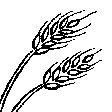
Cropland
- Annual cropping
- Perennial (non-woody) cropping
Annual cropping - Specify crops:
- fodder crops - alfalfa
- fodder crops - clover
- fodder crops - grasses
Perennial (non-woody) cropping - Specify crops:
- fodder crops - grasses
- fodder crops - legumes, clover
Number of growing seasons per year:
- 1
Is intercropping practiced?
Ja
If yes, specify which crops are intercropped:
A mix of grasses, clovers, and alfalfa.
Is crop rotation practiced?
Nee
Comments:
The area is generally classified as agricultural land but functions as a buffer zone along water bodies. Fodder crops are typically grown and either harvested for feed or mulched. In some cases, the area may be used for grazing livestock, although this is relatively rare.
3.3 Has land use changed due to the implementation of the Technology?
Has land use changed due to the implementation of the Technology?
- Yes (Please fill out the questions below with regard to the land use before implementation of the Technology)
Land use mixed within the same land unit:
Nee

Cropland
- Annual cropping
Annual cropping - Specify crops:
- cereals - barley
- cereals - maize
- cereals - wheat (winter)
Is intercropping practiced?
Nee
Is crop rotation practiced?
Ja
If yes, specify:
General crop rotation is practiced, typically alternating between cereals and maize.
3.4 Water supply
Water supply for the land on which the Technology is applied:
- rainfed
3.5 SLM group to which the Technology belongs
- improved ground/ vegetation cover
- surface water management (spring, river, lakes, sea)
- wetland protection/ management
3.6 SLM measures comprising the Technology
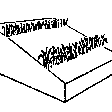
vegetative measures
- V1: Tree and shrub cover
- V2: Grasses and perennial herbaceous plants
- V5: Others
Comments:
It is considered a vegetative measure because it relies primarily on the establishment and management of permanent vegetation such as grasses, legumes (e.g., clover, alfalfa), shrubs, and trees.
3.7 Main types of land degradation addressed by the Technology
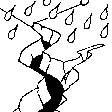
soil erosion by water
- Wt: loss of topsoil/ surface erosion
- Wr: riverbank erosion
- Wo: offsite degradation effects
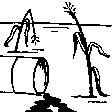
chemical soil deterioration
- Cn: fertility decline and reduced organic matter content (not caused by erosion)
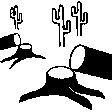
biological degradation
- Bc: reduction of vegetation cover
- Bh: loss of habitats
- Bs: quality and species composition/ diversity decline

water degradation
- Hw: reduction of the buffering capacity of wetland areas
3.8 Prevention, reduction, or restoration of land degradation
Specify the goal of the Technology with regard to land degradation:
- prevent land degradation
- reduce land degradation
4. Technical specifications, implementation activities, inputs, and costs
4.1 Technical drawing of the Technology
Technical specifications (related to technical drawing):
Riparian buffer strips are protected zones established along watercourses to reduce agricultural impacts on soil and water quality. These strips remain part of the agricultural land base and may be managed as grassland, limited arable land, or grazing areas. However, to maintain their protective function, specific agricultural inputs and activities are restricted within these areas. If the buffer strips are not properly maintained, they are excluded from the system of agricultural land in use and become ineligible for any subsidies.
Management and Activity Restrictions (applicable to buffer strips only):
Soil tillage: Deep ploughing is prohibited; only shallow (low) tillage is permitted for maintenance and sowing.
Buffer widths (according to the Water Act):
- 15 m along primary watercourses
- 5 m along secondary watercourses
- 3 m along drainage ditches
Vegetation allowed: Grass, grass-clover mixtures, clover-grass mixtures, alfalfa, clover, native shrubs, and trees.
Fertilization: Application of mineral and organic fertilizers is prohibited. Storage or disposal of manure is not allowed. Natural manure from grazing animals is tolerated.
Plant protection products: The use of pesticides has been prohibited in buffer strips since 2002.
Livestock grazing: Grazing is allowed but must not damage the structure of the water body. Animals may drink from the watercourse at designated points, but supplementary feeding is not permitted within the strip.
Author:
Gregor Kramberger
Date:
18/04/2025
4.2 General information regarding the calculation of inputs and costs
Specify how costs and inputs were calculated:
- per Technology area
Indicate size and area unit:
31,2 hectares
other/ national currency (specify):
EUR
If relevant, indicate exchange rate from USD to local currency (e.g. 1 USD = 79.9 Brazilian Real): 1 USD =:
0.87
Indicate average wage cost of hired labour per day:
114
4.3 Establishment activities
| Activity | Timing (season) | |
|---|---|---|
| 1. | Purchase grass seed mixture | 1st year |
| 2. | Pre-sowing preparation and sowing | 1st year |
Comments:
Select grass species or mixtures adapted to local soil and climatic conditions. Minimal soil disturbance recommended; shallow cultivation to ensure proper seed-soil contact.
4.4 Costs and inputs needed for establishment
| Specify input | Unit | Quantity | Costs per Unit | Total costs per input | % of costs borne by land users | |
|---|---|---|---|---|---|---|
| Labour | Own labor | hour | 3.0 | 9.0 | 27.0 | 100.0 |
| Labour | Pre-sowing preparation and sowing | hour | 3.0 | 35.0 | 105.0 | 100.0 |
| Plant material | Grass seed mixture | kg/ha | 16.412 | 5.6 | 91.91 | 100.0 |
| Total costs for establishment of the Technology | 223.91 | |||||
| Total costs for establishment of the Technology in USD | 257.37 | |||||
Comments:
Labor and pre-sowing preparation and sowing also include travel time between sites. The total size of the farm is 31,2 hectares. An area of 4103 m² falls under the restricted buffer strip zone at his farm.
4.5 Maintenance/ recurrent activities
| Activity | Timing/ frequency | |
|---|---|---|
| 1. | Mulching/mowing | 2 times per year |
| 2. | Pruning and clearing of overgrowth | 1 time, winter time |
Comments:
4103 m² of agricultural land represents the buffer strips that the farmer actively manages and maintains. Pruning or cutting of woody vegetation, such as trees or shrubs, when they begin to encroach on agricultural land near the riverbank. Farmers typically carry out this work in winter, but it is difficult to estimate the cost, as it can vary significantly depending on the extent of overgrowth.
4.6 Costs and inputs needed for maintenance/ recurrent activities (per year)
| Specify input | Unit | Quantity | Costs per Unit | Total costs per input | % of costs borne by land users | |
|---|---|---|---|---|---|---|
| Labour | Mulching/mowing | hours | 6.0 | 32.0 | 192.0 | 100.0 |
| Labour | Pruning and clearing of overgrowth | hours | 4.0 | 4.5 | 18.0 | 100.0 |
| Labour | Own labor | hours | 10.0 | 9.0 | 90.0 | 100.0 |
| Total costs for maintenance of the Technology | 300.0 | |||||
| Total costs for maintenance of the Technology in USD | 344.83 | |||||
Comments:
Opportunity costs were calculated based on the loss of arable land due to the establishment of buffer zones in 2024 on Farm Ropic (total farm size: 32,2 ha, of which 28,6 ha is arable land). The planned crop rotation for that year included wheat, oil pumpkins, barley, and maize. The income foregone represents the estimated revenue that could have been generated from these crops on the area now designated as buffer strips (a total of 4103 m² of arable land).
The estimated income losses by crop type are:
Winter wheat: 113.52 €
Oil pumpkin: 396.80 €
Winter barley: 120.60 €
Grain maize: 68.04 €.
4.7 Most important factors affecting the costs
Describe the most determinate factors affecting the costs:
Exact costs are difficult to estimate as they depend heavily on the specific location. If regular maintenance, such as mulching/mowing, is carried out, annual costs remain low, and pruning and clearing of overgrowth work is likely unnecessary. Costs are calculated for farm Ropič.
5. Natural and human environment
5.1 Climate
Annual rainfall
- < 250 mm
- 251-500 mm
- 501-750 mm
- 751-1,000 mm
- 1,001-1,500 mm
- 1,501-2,000 mm
- 2,001-3,000 mm
- 3,001-4,000 mm
- > 4,000 mm
Specify average annual rainfall (if known), in mm:
1032.00
Specifications/ comments on rainfall:
The most precipitation falls in summer, the months with the highest average precipitation are August and September, the least precipitation falls in winter, in January and February at least, and in principle more precipitation falls in autumn than in spring.
Indicate the name of the reference meteorological station considered:
Jareninski Vrh (1991-2020)
Agro-climatic zone
- sub-humid
The average annual air temperature at Jareninski Vrh during the reference period 1991–2020 was 10.1 °C.
5.2 Topography
Slopes on average:
- flat (0-2%)
- gentle (3-5%)
- moderate (6-10%)
- rolling (11-15%)
- hilly (16-30%)
- steep (31-60%)
- very steep (>60%)
Landforms:
- plateau/plains
- ridges
- mountain slopes
- hill slopes
- footslopes
- valley floors
Altitudinal zone:
- 0-100 m a.s.l.
- 101-500 m a.s.l.
- 501-1,000 m a.s.l.
- 1,001-1,500 m a.s.l.
- 1,501-2,000 m a.s.l.
- 2,001-2,500 m a.s.l.
- 2,501-3,000 m a.s.l.
- 3,001-4,000 m a.s.l.
- > 4,000 m a.s.l.
Indicate if the Technology is specifically applied in:
- concave situations
Comments and further specifications on topography:
There are depressions, settlements are in the valley, concave type.
5.3 Soils
Soil depth on average:
- very shallow (0-20 cm)
- shallow (21-50 cm)
- moderately deep (51-80 cm)
- deep (81-120 cm)
- very deep (> 120 cm)
Soil texture (topsoil):
- medium (loamy, silty)
Soil texture (> 20 cm below surface):
- medium (loamy, silty)
Topsoil organic matter:
- high (>3%)
5.4 Water availability and quality
Ground water table:
5-50 m
Availability of surface water:
good
Water quality (untreated):
for agricultural use only (irrigation)
Water quality refers to:
surface water
Is water salinity a problem?
Nee
Is flooding of the area occurring?
Ja
Regularity:
episodically
Comments and further specifications on water quality and quantity:
Hydromelioration was carried out in the area, a drainage system and water retention systems (e.g. ponds and basins) were arranged.
5.5 Biodiversity
Species diversity:
- medium
Habitat diversity:
- medium
5.6 Characteristics of land users applying the Technology
Sedentary or nomadic:
- Sedentary
Market orientation of production system:
- commercial/ market
Off-farm income:
- 10-50% of all income
Relative level of wealth:
- average
Individuals or groups:
- individual/ household
Level of mechanization:
- mechanized/ motorized
Gender:
- men
Age of land users:
- middle-aged
5.7 Average area of land used by land users applying the Technology
- < 0.5 ha
- 0.5-1 ha
- 1-2 ha
- 2-5 ha
- 5-15 ha
- 15-50 ha
- 50-100 ha
- 100-500 ha
- 500-1,000 ha
- 1,000-10,000 ha
- > 10,000 ha
Is this considered small-, medium- or large-scale (referring to local context)?
- medium-scale
5.8 Land ownership, land use rights, and water use rights
Land ownership:
- individual, titled
Land use rights:
- leased
- individual
Water use rights:
- communal (organized)
Specify:
Based on national legal system.
5.9 Access to services and infrastructure
health:
- poor
- moderate
- good
education:
- poor
- moderate
- good
technical assistance:
- poor
- moderate
- good
employment (e.g. off-farm):
- poor
- moderate
- good
markets:
- poor
- moderate
- good
energy:
- poor
- moderate
- good
roads and transport:
- poor
- moderate
- good
drinking water and sanitation:
- poor
- moderate
- good
financial services:
- poor
- moderate
- good
6. Impacts and concluding statements
6.1 On-site impacts the Technology has shown
Socio-economic impacts
Production
crop production
Comments/ specify:
The loss of productive farmland depends on the width of buffer strips and the total farm size. Impact on yield varies depending on the previous land use (e.g., maize, wheat, barley were replaced by permanent vegetation).
fodder production
Comments/ specify:
Some farmers report that grasses grown in riparian buffer strips can be harvested for hay or grazed by livestock, partially compensating for lost crop land. Dairy or mixed farms benefit more from fodder production.
production area
Comments/ specify:
The implementation of riparian buffer strips directly reduces the production area, as these zones must be permanently maintained with grass, shrubs, or trees instead of crops.
land management
Comments/ specify:
Less flexibility in field layout and crop management (without plowing, fertilization, or pesticides). Additional maintenance like mulching and active cultivation area is reduced. Buffer strips create machinery access/driving zones and reduce erosion.
Water availability and quality
drinking water quality
Comments/ specify:
They filter agricultural runoff and prevent fertilizers, pesticides and sediments from entering waterways. They reduce nitrate leaching and chemical pollution, improving the quality of groundwater and surface water.
water quality for livestock
Comments/ specify:
They filter pollutants before they reach streams and water sources, improving water quality for grazing animals.
Income and costs
farm income
Comments/ specify:
The loss of productive land due to buffer strips reduces crop output, affecting farm revenue.
workload
Comments/ specify:
Farmers need to mow or mulch buffer strips regularly to prevent overgrowth. Sometimes tree maintenance is necessary.
Socio-cultural impacts
recreational opportunities
Comments/ specify:
Access to water bodies for recreational purposes.
Ecological impacts
Water cycle/ runoff
water quality
Comments/ specify:
They filter out nitrates, phosphorus, pesticides, and sediments before they reach water bodies.
surface runoff
Comments/ specify:
They slow surface runoff, increase water infiltration, and reduce the transport of sediments, fertilizers, and pesticides into water bodies.
Soil
soil cover
Comments/ specify:
They maintaiThey maintain continuous vegetation cover in the zone around the water body.n continuous vegetation cover and reduce soil exposure to erosion.
soil loss
Comments/ specify:
They significantly reduce soil erosion, they stabilize the soil and trap sediment, especially during floods.
Biodiversity: vegetation, animals
Vegetation cover
Comments/ specify:
Permanent vegetation cover in buffer strips, improving soil stability and biodiversity.
plant diversity
Comments/ specify:
Increased diversity of grasses, legumes, shrubs, and trees, creating a more resilient ecosystem.
animal diversity
Comments/ specify:
Riparian buffer strips provide habitat for birds, insects, amphibians, and small mammals, increasing biodiversity and ecological stability.
beneficial species
Comments/ specify:
Increased presence of pollinators, predatory insects, and other beneficial organisms.
habitat diversity
Comments/ specify:
With riparian buffer strips we create diverse habitats by introducing a mix of grasses, shrubs, and trees, supporting a wider range of species.
Climate and disaster risk reduction
flood impacts
Comments/ specify:
Deep-rooted vegetation stabilizes riverbanks, preventing erosion and minimizing damage during high water events.
Specify assessment of on-site impacts (measurements):
The data provided are not based on direct measurements but are derived from statements by the land user (farmer) and expert judgement from an agricultural adviser. They reflect practical experience and informed estimates rather than measured field data.
6.2 Off-site impacts the Technology has shown
groundwater/ river pollution
Comments/ specify:
Due to a significant reduction in the leaching of pollutants, leading to cleaner water sources.
buffering/ filtering capacity
Comments/ specify:
Significant reduction in pollutants as buffer strips trap sediments and filter nutrients and chemicals before reaching watercourses.
Specify assessment of off-site impacts (measurements):
The data provided are not based on direct measurements but are derived from statements by the land user (farmer) and expert judgement from an agricultural adviser. They reflect practical experience and informed estimates rather than measured field data.
6.3 Exposure and sensitivity of the Technology to gradual climate change and climate-related extremes/ disasters (as perceived by land users)
Gradual climate change
Gradual climate change
| Season | increase or decrease | How does the Technology cope with it? | |
|---|---|---|---|
| annual temperature | increase | moderately | |
| seasonal temperature | summer | increase | moderately |
| seasonal temperature | spring | increase | moderately |
| seasonal temperature | autumn | increase | moderately |
| seasonal temperature | winter | increase | moderately |
| seasonal rainfall | summer | increase | very well |
| seasonal rainfall | spring | increase | very well |
| seasonal rainfall | autumn | decrease | moderately |
Climate-related extremes (disasters)
Meteorological disasters
| How does the Technology cope with it? | |
|---|---|
| local rainstorm | very well |
Climatological disasters
| How does the Technology cope with it? | |
|---|---|
| heatwave | well |
Hydrological disasters
| How does the Technology cope with it? | |
|---|---|
| general (river) flood | very well |
| flash flood | very well |
6.4 Cost-benefit analysis
How do the benefits compare with the establishment costs (from land users’ perspective)?
Short-term returns:
slightly negative
Long-term returns:
slightly positive
How do the benefits compare with the maintenance/ recurrent costs (from land users' perspective)?
Short-term returns:
neutral/ balanced
Long-term returns:
positive
Comments:
Establishment costs are high, including soil preparation, seeding, and potential fencing, while the loss of productive land immediately reduces farm income. Subsidies may offset some costs, but they do not fully compensate for the initial financial impact. In a long-term benefits such as improved soil stability, water quality, and flood protection reduce future expenses. Over time, subsidies, reduced erosion, and potential fodder production help balance the initial investment.
Maintenance costs, such as mowing or mulching and tree maintenance, add labor and equipment expenses, but the absence of fertilizer and pesticide costs helps balance them. Subsidies for maintaining buffer strips further offset these recurrent costs, keeping short-term financial impact neutral. Once vegetation is established, maintenance costs decrease, requiring only occasional mowing or grazing. Over time, benefits like erosion control, improved soil health, and reduced flood damage outweigh the minimal upkeep expenses, making the practice economically sustainable.
6.5 Adoption of the Technology
- > 50%
If available, quantify (no. of households and/ or area covered):
All farmers in the area must comply with the implementation of riparian buffer strips as part of the GAEC 4 standard under CAP conditionality. This means that all agricultural land users with fields adjacent to watercourses are required to establish and maintain these protective strips, ensuring compliance with national and EU environmental regulations.
Of all those who have adopted the Technology, how many did so spontaneously, i.e. without receiving any material incentives/ payments?
- 0-10%
6.6 Adaptation
Has the Technology been modified recently to adapt to changing conditions?
Ja
other (specify):
CAP
Specify adaptation of the Technology (design, material/ species, etc.):
The requirements for riparian buffer strips have been updated to align with GAEC 4 conditionality and the EU Strategic Plan Regulation. The establishment of buffer strips is now mandatory along first-order watercourses (15 m wide), second-order watercourses (5 m wide), and drainage ditches (3 m wide).
Within these buffer zones, the use of organic and mineral fertilizers, as well as plant protection products (PPPs), is strictly prohibited. Ploughing is not allowed, but shallow tillage is permitted for maintenance (mowing, mulching, or grazing) and for preparing soil for sowing approved crops.
The buffer strips can be covered with grass, grass-legume mixtures, clover, alfalfa, naturally occurring vegetation, shrubs, or trees. Livestock grazing is permitted but must not alter the structure of the riverbank. Animals cannot be supplementary fed within the buffer zones and must be provided drinking water only at designated, controlled locations in small groups to minimize environmental impact.
6.7 Strengths/ advantages/ opportunities of the Technology
| Strengths/ advantages/ opportunities in the land user’s view |
|---|
| Buffer strips stabilize soil and prevent erosion. |
| They reduce the impact of flooding on agricultural land. |
| Less leaching of nutrients and plant protection products into water. |
| Additional turning point and driving path for machines. |
| Establishing and maintaining buffer strips can qualify farmers for financial incentives and support programs. |
| Additional shelters for wildlife. |
| Strengths/ advantages/ opportunities in the compiler’s or other key resource person’s view |
|---|
| These buffers effectively filter out nutrients, pesticides, and sediments from agricultural runoff, thereby enhancing the quality of nearby water bodies. |
| By stabilizing stream banks, riparian buffers reduce soil erosion, preserving valuable topsoil and maintaining land productivity. |
| They provide critical habitats for various wildlife species, promoting biodiversity and creating wildlife corridors in agricultural landscapes. |
| Riparian buffer strips contribute to ecosystem services like carbon sequestration and pollination, supporting broader environmental goals. |
6.8 Weaknesses/ disadvantages/ risks of the Technology and ways of overcoming them
| Weaknesses/ disadvantages/ risks in the land user’s view | How can they be overcome? |
|---|---|
| The buffer zones are too wide, significantly reducing cultivated land area, which negatively impacts crop yields and farm income. | Increase subsidies and financial incentives for farmers to compensate for the loss of productive land within riparian buffer strips. |
| Maintenance tasks such as mowing, mulching, or controlled grazing require extra labor and resources and establishing buffer strips involves expenses for seeds, machinery, soil preparation, and potential fencing. | Provide additional payments for ongoing maintenance activities or investment support to offset initial establishment costs. |
| The legislation and administrative requirements are complex, involving numerous regulations that farmers find difficult to understand and follow. | Provide more accessible, user-friendly information, along with targeted advisory services and educational programs to help farmers better navigate these rules. |
| Weaknesses/ disadvantages/ risks in the compiler’s or other key resource person’s view | How can they be overcome? |
|---|---|
| In certain conditions, the redirected flow of water due to buffer strips may weaken streambanks, leading to erosion and land loss. | Designing buffer zones with appropriate vegetation, width and adapted to local conditions, and regularly monitoring the situation. |
| Over time, buffer strips can become saturated with nutrients, reducing their effectiveness and possibly turning them into sources of pollution. | Regular vegetation management, harvesting or removal of biomass to prevent nutrient accumulation. Crop rotation or periodic rejuvenation of buffer zone vegetation to maintain its filtering capacity. |
| Proper upkeep involves tasks like weed control, pruning, replanting, and protection against wildlife, increasing the workload for farmers. | Provide farmers with targeted financial support or subsidies for maintenance tasks, promote low-maintenance vegetation species, and offer technical assistance or training in efficient management practices. |
| Initial setup requires investment in planting, while ongoing maintenance demands additional labor and resources. | Offer financial incentives, subsidies, or cost-sharing programs to cover initial establishment expenses, and provide ongoing support or training to minimize labor and maintenance costs. |
7. References and links
7.1 Methods/ sources of information
- interviews with land users
1 (Andrej Ropič, farmer)
- interviews with SLM specialists/ experts
2 (Chamber of Agriculture and Forestry of Slovenia (KGZS) – Institute of Agriculture and Forestry Maribor; Tamara Korošec and Timotej Horvat)
- compilation from reports and other existing documentation
CAP and Slovenian Strategic Plan 2023-2027.
When were the data compiled (in the field)?
17/01/2023
Comments:
Visit to the farm and farmer interview.
7.2 References to available publications
Title, author, year, ISBN:
Cole, L. J., Stockan, J., & Helliwell, R. (2020). Managing riparian buffer strips to optimise ecosystem services: A review. Agriculture, Ecosystems & Environment, 296, 106891.
Available from where? Costs?
https://doi.org/10.1016/j.agee.2020.106891
Title, author, year, ISBN:
Macleod, C. J. A., Haygarth, P. M., et al. (2022). Impacts of different vegetation in riparian buffer strips on runoff and suspended sediment loss. Environmental Research Communications, 4(1), 015001.
Available from where? Costs?
https://doi.org/10.1088/2515-7620/ac3c2b
Title, author, year, ISBN:
Dlamini, J. C., Cardenas, L. M., Tesfamariam, E. H., Dunn, R. M., Loick, N., Charteris, A. F., Cocciaglia, L., Vangeli, S., Blackwell, M. S. A., Upadhayay, H. R., et al. (2022). Riparian buffer strips influence nitrogen losses as nitrous oxide and leached N from upslope permanent pasture. Agriculture, Ecosystems &
Available from where? Costs?
https://doi.org/10.1016/j.agee.2022.108031
Title, author, year, ISBN:
Lešnik, T., Bogovič, D., Pokupec, D., & Borec, A. (2024). The impact of riparian zones along rivers under the new CAP in Slovenia. Journal of Central European Agriculture, 25(4), 1185–1192.
Available from where? Costs?
https://doi.org/10.5513/JCEA01/25.4.4348
7.3 Links to relevant online information
Title/ description:
Ministry of Agriculture, Forestry and Food. (2024). Unified Application 2024: Guidelines for the implementation of interventions under the Strategic Plan of the Common Agricultural Policy 2023–2027. Ljubljana, Slovenia.
URL:
https://www.kgzs.si/uploads/eiv24/NAVODILA%201/00_VELIKA_NAVODILA_2024_-_CELOTA_-_28_5_24.pdf
Links and modules
Expand all Collapse allLinks
No links
Modules
No modules


